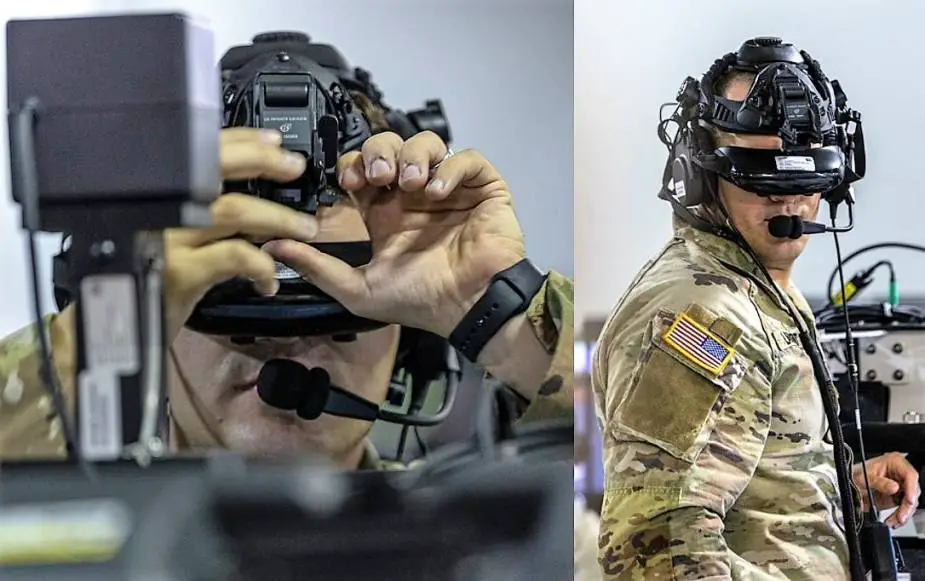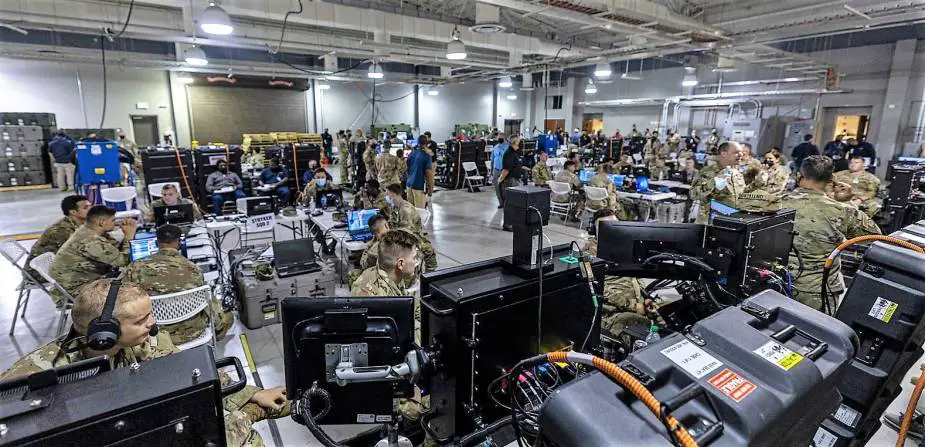Soldier insights drive US Army development of mixed-reality training system
On a mid-August afternoon in central Texas, Soldiers in combat uniform gather together, preparing to engage in realistic battlefield training. With temperatures outside approaching the high 90s, one might expect the upcoming drill, situated amid a flat and dusty expanse at Fort Hood, to verge on the sweltering. Maureena Thompson, Army Futures Command, reports.
Follow Army Recognition on Google News at this link

A U.S. soldier adjusts his virtual reality headset during an evaluation of the Synthetic Training Environment’s Reconfigurable Virtual Collective Trainer at Fort Hood, Texas, on Aug. 17, 2022. (Picture source: U.S. Army photo by Anthony Sualog, Army Futures Command)
Instead, this particular group of Soldiers is training inside the walls of the post’s Close Combat Tactical Training Center, surrounded by the steady hum of computers and a reliable flow of cool air conditioning.
The center, which facilitates state-of-the-art virtual collective training for warfighters, is hosting approximately 150 Soldiers from Fort Bliss, Texas and Fort Carson, Colorado, this month as part of an operational assessment led by the U.S. Army Test and Evaluation Command.
The purpose of the assessment is to understand how Soldiers interact with the newest software and hardware iterations of the Army’s Synthetic Training Environment, or STE, a capability that blends virtual, live and collective training elements to produce an immersive experience that is location-agile and minimizes use of real firepower and other typically costly, one-time-use training resources.

Approximately 150 Soldiers from installations in Texas and Colorado are taking part in the Synthetic Training Environment Information System and Reconfigurable Virtual Collective Trainer operational assessment at Fort Hood, Texas, this August. (Picture source: U.S. Army photo by Anthony Sualog, Army Futures Command)
Undergoing analysis at the event are two elements of the broader STE, the Information System, shortened STE-IS, and the Reconfigurable Virtual Collective Trainer, or RVCT.
The STE-IS is an intelligent suite of training simulation and management software that supports intuitive access and simultaneous training at multiple locations. The STE-IS also encompasses One World Terrain, a 3D mapping dataset that allows training coordinators to integrate actual terrain imagery from around the globe.
The RVCT is a highly adaptable hardware system that connects to the STE-IS to activate collective, mixed-reality training scenarios. The RVCT consists of high-tech, interactive equipment — including a heads-up display, high-resolution monitor and representational controllers — that enables Soldiers, squads, platoons and companies to navigate exercises using actual and computer-generated movements.
The STE-IS-powered family of RVCT systems is capable of replicating key aviation and ground platforms; the Fort Hood event is focused on RVCT ground models that can replicate Abrams, Bradley and Stryker fighting vehicles, as well as dismounted infantry.
Beyond testing out the new equipment, Soldiers are providing critical feedback and data to STE development teams on the utility of the existing software and hardware and how it could be tweaked to portray in-person combat with greater realism.
Soldiers participating in the assessment readily offer ideas on how to enhance current systems, such as by varying the volume of sound effects and making simulated movements smoother.
Initial insights emerging from the Soldier feedback process were shared with Army leaders, including Lt. Gen. Maria R. Gervais, Deputy Commanding General and Chief of Staff of the U.S. Army Training and Doctrine Command, during a distinguished visitor day held at the Close Combat Training Center on Aug. 17.
Col. Cory Berg, Project Manager Soldier Training at the U.S. Army Program Executive Office Simulation, Training and Instrumentation, or PEO STRI, explained during the program that part of the STE’s uniqueness lies in its ability to “capitalize on communally available equipment and capabilities.”
Col. Nick Kioutas, Project Manager Synthetic Environment at PEO STRI, emphasized that the Army will “also be able to exploit the new technologies in gaming” as it advances the STE with the help of industry partners.
“We want to keep evolving this as we move forward,” said Col. Mike McCarthy of the of the STE Cross-Functional Team, an Army Futures Command modernization accelerator that assists the Army with defining and coordinating STE requirements. McCarthy highlighted how the STE’s intentional use of a Modular Open Systems Approach has helped to maximize the ease of use, efficiency and adaptability of the equipment under development.
Also in attendance at the event was Brig. Gen. William R. Glaser, Director of the STE Cross-Functional Team, who saw clear benefits in documenting the reactions and suggestions of Soldiers trying out the nascent equipment. He explained that the STE Cross-Functional Team provides abbreviated capability development documents, and capabilities and limitations reports to operational assessment teams in order to guide their focus while simultaneously confirming the accuracy and feasibility of outlined requirements. “This is an effort in progress,” Glaser said, adding that the collaborative assessment serves as an invaluable opportunity for Army modernization and training stakeholders to “check our math and make sure that we’re headed in the right direction.”


























